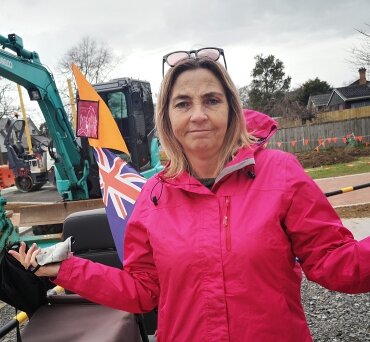
Tania Cochrane

Tania Cochrane calls the $1.6 million Hamilton Road Cycleway project a disaster. Photo: Mary Anne Gill
Money ear-marked for consultation with residents over the controversial Hamilton Road dual cycleway has gone unspent and will go instead on promotional activities after its completion.
Many residents, including Grey Street Dairy owner Wei Na who faces financial ruin because of the project, say the scope of it and the lack of consultation took them by surprise.
Hall and Grey streets have been closed off or made one-way while the adjacent Bryce and Vogel streets are experiencing higher traffic volumes, according to sources.
The Hamilton Road project was expected to be finished by now but has been delayed by Covid-19 worksite restrictions.
Resident Tania Cochrane, who launched a petition to save the Grey St Dairy when its revenue dropped following the closure of the street for turning traffic from Hamilton Road, said the council did not listen to their concerns.
“They just had this money from NZTA and wanted to spend it before it wasn’t available anymore,” she said.
“It has been a disaster.”

Elise Badger
The controversy prompted Cambridge Community Board member Elise Badger to ask Waipā District Council to provide her with a copy of the project’s $14,000 communications strategy.
Included in that plan was a soil-turning event costing $6000 and $3000 for a video.
“Did those things happen?” she asked Transportation manager Bryan Hudson at last week’s board meeting.
“I’m not sure honestly. I didn’t go to a sod turning event,” he said.
Badger then asked why residents in Vogel and Bryce streets were not included in the consultation given more traffic would be diverted down their streets.
“Yes, I know that would probably have been a good idea,” he said noting the message must have got through in other ways as several residents in those streets provided feedback.
“There could have been a wider catchment of the community consulted on that project based on how it was going to affect them,” said Badger.

Bryan Hudson
Hudson told the board the council learned some good lessons.
Later he told The News the lessons were around timing and resourcing.
“We often found that residents at our drop-in sessions were speaking more about the Streets for People or Urban Mobility in general rather than having any particular concerns they wanted to raise about Hamilton Road Cycleway.”
It reiterated the importance of having clear, concise communication and a good reminder that communicating early and often with residents, businesses and stakeholders goes a long way towards the overall success of a project, he said.
Badger told The News this week she was “disappointed” that more than half the $14,000 set aside for consultation went unspent.
“Anytime the community doesn’t feel heard, then we have to look at the process,” she said.

Sue Milner
Board chair Sue Milner said she had heard the “grizzles” about the project.
“Bryce Street was already a rat run and it’s got worse.
“I think for things like this, we’ve got to get better engaged.”
The board was not consulted in depth – it was presented with a fait accompli – but in hindsight should have been more vocal about the project, she said.
Milner praised Badger for her persistence saying: “she’s doing a great job.”
Two information evenings, several face-to-face visits held, and 700 brochures distributed, according to the council.
It is not the only time there has been criticism of the council’s engagement on the $1.6 million project. Just over half of the cost will be met by Waka Kotahi NZ Transport Agency, the rest by ratepayers.
Earlier this year lawyer Andrea Twaddle told the council its consultation was “defective”, and they should “go back and do the consultation properly.”
Read: Road change almost done
Read: 60-year-old dairy faces closure

Tania Cochrane








